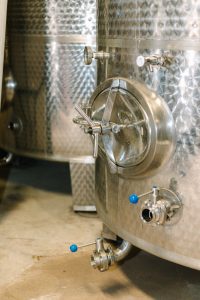While many winemakers tend to focus heavily on operations and timeliness during harvest, the reality is that post-fermentation processes tend to require a better understanding by many winemakers.
Failing to recognize when an operational step is required can be heavily detrimental to wine quality and extend resources of winery employees that are unnecessary. For example, for white wines that are not destined for an immediate bottling (i.e., by the February following harvest season), then there is no need to A) immediately filter and clarify the wine or B) immediately add bentonite post-fermentation. I find that many winemakers either lack patience with these steps. Most wines naturally clarify if given the proper storage conditions and time. Winemakers may also rush these processes due to a lack of understanding on why wines do not need to be immediately clear post-fermentation.
If this is you, please read on!
A Tangent on Wine Clarification & Temperature Control
Obviously, there are some exceptions to this argument about post-fermentation clarification, but in general, wines do not need to be immediately clear. One big exception includes wines that get bottled within a month or 2 after fermentation. There is an obvious rush there through winemaking operations.

Photo by: Savannah Smith Photography
However, most wines will naturally clarify post-fermentation with adequate temperature drops (45 – 55°F) and with a little time. That “little time” can vary, specifically, from vintage to vintage depending on the growing conditions of the fruit, quality of the fruit upon harvest, and harvest/fermentation treatments to the wine.
If you find yourself shaking your head over the temperature recommendation, please realize that this is one of the reasons so many winemaking experts, myself included, will recommend the use of tank temperature control (or barrel room temperature control) for making wine. The storage temperature and wine temperature will influence the rate of logistics in getting a wine to bottle, determine the order of wine processing operations, and, truth be told, have a good effect on wine quality.
If you have taken up the general recommendation that wines can sit at 65°F while in tank, then you have to accept the following winemaking conditions:
- The free SO2 of the wine is going to deplete quicker. This means that someone has to measure free and total SO2 more regularly (at least once per month, maybe more) and make more frequent SO2 additions to ensure the proper concentration.
- The wine’s aromatics will decrease quicker. Wines that are left in warmer temperatures will blow off more aromatics as time progresses. For some wines, that is okay. For others, like many Vitis vinifera and hybrid varieties, the loss of aromatics tends to have an overall negative affect on wine quality.
- Wine spoilage can occur suddenly and aggressively. We, as humans, prefer to work in a comfortable working temperature around that 65°F mark. However, so do many microorganisms. No wine is free of microorganisms, including the microorganisms that can ultimately spoil the wine. From my experience most films and wine spoilage problems occur quite quickly (in less than a month’s time) when wines are stored around 60 – 65°F. This is likely because that temperature range is ideal for the growth of most spoilage microorganisms.
- The wines will have to get stabilized and processed for bottle quicker. It’s not that you cannot make good wine without tank temperature control. You can! I help many wineries do just that! However, you do have to know what you are doing and know the operations that most optimize wine quality under these higher temperature storage conditions if your goal is to bottle high quality wines. This is where I find most winemakers struggle: they have learned to habitually keep wines within a comfortable temperature range without understanding the essentiality of other processes, timelines, or how the storage temperature influences quality. Typically, in order to optimize wine quality, wines stored around that 65°F temperature need bottled before June/July of the following season in order to avoid large temperature spikes in the wine processing area that naturally come with summer climates and are, otherwise, detrimental to wine quality through all of the reasons listed above.
Don’t Get Defeated: Get Savvy
I’m not going to leave you hanging here!
Like I mentioned above, you can make good quality wines even if you are lacking something like tank temperature control. This doesn’t mean I believe we should all eliminate tank temperature control. Not at all! In fact, once wineries integrate tank temperature control or barrel storage rooms with independent temperature/humidity controls, they find that A) operations becomes easier, B) they have more tools at their disposal to make different styles of wine, C) wine problems tend to decrease, and D) wine quality improves overall.
Nonetheless, in order to help winemakers first hand with their post-fermentation operations, I have started standardizing my recommendations for stabilization and, basically, pre-bottling operations. If you find yourself altering various techniques, or operational order, or waiting long periods of time in between various wine operations (like cold stabilization and filtration, for example), then these guidelines are for you!
A few years ago, I started a series of “Pre-Bottling” Checklists. This year, I’m happy to say these Checklists are now new and improved, broken down by wine color/type, and ordered based on cold stabilization preferences by the winery (i.e., use of tartrate inhibitors or use of traditional cold stabilization processes).
Since I find myself often telling winemakers, “Wait 2 days before doing ‘x,’ these Checklists also include a timeline of when those operations take place before the wine is bottled. For example, a week before starting filtration, generally, wines are brought up to room/bottling temperature and provided with a series of additions like sugar, preservatives, and possibly filtration-aid enzymes.
Today, there are Checklists for the following types of wine:
- White Wine
- With traditional cold stabilization processes (contact seeding or natural cold stabilization)
- With tartrate inhibition
- Rosé Wine
- With traditional cold stabilization processes (contact seeding or natural cold stabilization)
- With tartrate inhibition
- Red Wine
- Without cold stabilization
- With tartrate inhibition
- Native Wine Varieties (e.g., Concord, Niagara, Catawba, Muscadine)
- With both traditional cold stabilization processes and tartrate inhibition due to the common presence of tartrate crystals
- Formula Wine
- With traditional cold stabilization processes (contact seeding or natural cold stabilization)
- With tartrate inhibition
The Pre-Bottling Checklists are written in an order to optimize wine quality. Therefore, you may find my recommended order a bit different than other winemaking recommendations that optimize winemaking logistics.
Get Ready to Optimize Wine Quality with These Essential Processes

Photo by: Savannah Smith Photography
If you aren’t already, check out the DGW Insider and Elite Membership options to gain access to these and many more winemaking resources. Elite Members gain the extra benefit of chiming into our twice-monthly Q&A sessions to gain more insight and clarification on the plethora of resources available through DG Winemaking.
Changing your winemaking habits can cost as little as $35/month. Are you ready to take that plunge?
The views and opinions expressed through dgwinemaking.com are intended for general informational purposes only. Denise Gardner Winemaking does not assume any responsibility or liability for those winery, cidery, or alcohol-producing operations that choose to use any of the information seen here or within dgwinemaking.com.
